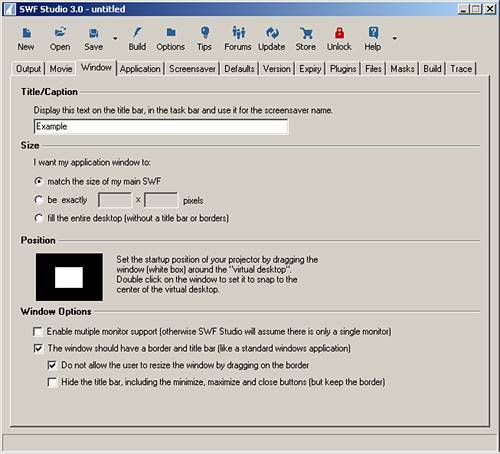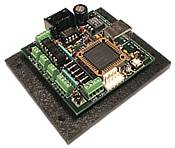Beyond the Web
| Flash does come bundled with the ability to export its content in the form of a projector file, which means it can be placed on a CD and distributed without the need for the player because the projector file has its own built-in player. You can also export in the form of a QuickTime movie (.mov) if you have the required plug-in, which costs about $30. But both of these formats have their shortcomings. Even though projector files can be easily created, they are not very powerful and have difficulty interacting with the user's computer. This section focuses on three applications that will help take your Flash content to places you might never have imagined, starting with screen savers. ScreenTimeScreenTime is an application built to allow users to quickly build screen savers for both Windows and Macintosh platforms with their Flash movies. How easy is it to use? These are the directions from their website:
And that is it. Of course, you can do more steps if you like to further customize your screen saver, and you can even create another Flash file to be the control panel for your screen saver for other users to make adjustments to variables. ScreenTime can be found at http://www.screentime.com/software/stf/; it does have a trial version, and the commercial version is about $200. Another format you might want to put your Flash content in is video, and as mentioned before, with the correct plug-in you can export your Flash files in QuickTime (.mov) format. But what if you want to export in another video format? SWF2VideoSWF2Video allows Flash designers and developers to convert their SWF files to AVI video files while maintaining ActionScript and interactivity. It can even do batch jobs converting several compiled Flash files to AVI. You can find SWF2Video at http://www.flashants.com/root/swf2video.shtml. It does have a trial version available for download, and to purchase the full version will set you back about $80. Also available on their site is an SWF2Video plug-in for Adobe Premier. This plug-in will allow Adobe Premier users to import SWF files directly into Premier for editing. The final third-party application that can help take your Flash content beyond the Web is SWF Studio 3.0. SWF Studio 3.0SWF Studio 3.0 is the last third-party application in this chapter for a reason. It can take your Flash file and convert it to a full-blown desktop application. It accomplishes this by wrapping the compiled SWF file with several plugins that can be accessed by using the ActionScript objects that are installed with the application. Here is an example that will send a message to a pop-up window when it has been wrapped with SWF Studio: ssCore.App.showMsgBox({icon:"question",buttons:"YesNoCancel",defaultButton: "button1",prompt:"Isn't this cool?",title:"Simple Question"}); Of course, that is a very generic example of what can be done. Using SWF Studio, you can interact with an FTP server, the user's local computer file system, as well as the registry, and even create your own browser. For an example with all source code, go to the companion site for a simple MP3 player. SWF Studio has a very easy-to-use interface, as you can see in Figures 28.6. Figure 28.6. SWF Studio 3.0. In addition, you can download another app called Code Builder, which will help you get started writing code for SWF Studio. SWF Studio is not limited to creating desktop applications; it can also create screensavers. SWF Studio can be found at http://www.northcode.com and it does have a free trial download. The purchase price for the full version is about $299. SWF Studio is not the only application that can create desktop apps from your Flash files, for a full list of reviews, try this link: http://www.flashmagazine.com/1100.htm. And although SWF Studio is the last application we cover in this chapter, there is still one place we have not taken Flash, into the real world. MakingThingsMakingThings is a company out of San Francisco, California, that produces teleo modules. Teleo modules are small calculator size circuit boards that can send information to, or receive information from Flash by means of an XML socket server and USB connection. You can see a picture of a teleo module in Figure 28.7. Figure 28.7. The introductory module from MakingThings.
And these circuit boards can receive data from buttons, switches, and photocells, anything that can send a digital or analog signal. They can also control any electronic device including lights, motors, and buzzers. The software required to run these modules is free and will run on both Mac and PC. The modules themselves range around $150 or more, depending on what you are trying to accomplish. The introductory module, a good module to start with, is $159. They can all be found at http://www.makingthings.com. |
EAN: 2147483647
Pages: 319
